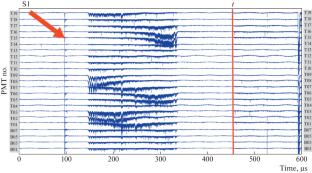RED-100两相氙发射探测器中宇宙介子产生的电子噪声
IF 0.4
4区 工程技术
Q4 ENGINEERING, MULTIDISCIPLINARY
引用次数: 0
摘要
结果表明,在以液态氙为工作物质的地面实验室中工作的RED-100两相发射探测器的工作体积是特征频率为~200 kHz的单电子噪声信号的来源。讨论了这些噪声产生的可能机理和抑制噪声的方法。本文章由计算机程序翻译,如有差异,请以英文原文为准。

Electron Noise Generated by Cosmic Muons in the RED-100 Two-Phase Xenon Emission Detector
It is shown that the working volume of the RED-100 two-phase emission detector, which operates in a ground-based laboratory with liquid xenon used as a working substance, is a source of single-electron noise signals with a characteristic frequency of ~200 kHz. Possible mechanisms of generation of these noises and methods for their suppression are discussed.
求助全文
通过发布文献求助,成功后即可免费获取论文全文。
去求助
来源期刊

Instruments and Experimental Techniques
工程技术-工程:综合
CiteScore
1.20
自引率
33.30%
发文量
113
审稿时长
4-8 weeks
期刊介绍:
Instruments and Experimental Techniques is an international peer reviewed journal that publishes reviews describing advanced methods for physical measurements and techniques and original articles that present techniques for physical measurements, principles of operation, design, methods of application, and analysis of the operation of physical instruments used in all fields of experimental physics and when conducting measurements using physical methods and instruments in astronomy, natural sciences, chemistry, biology, medicine, and ecology.
 求助内容:
求助内容: 应助结果提醒方式:
应助结果提醒方式:


